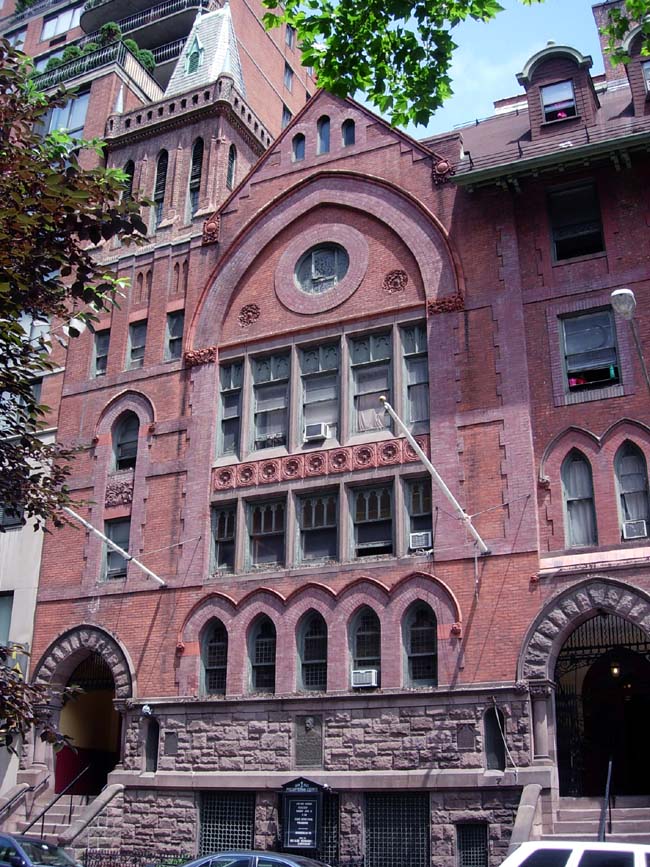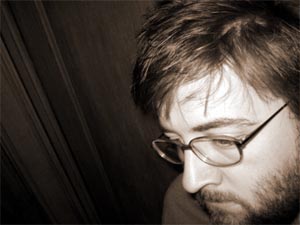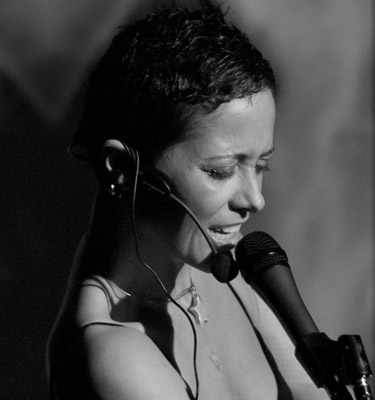 |
![[ Composer's Voice ]](http://www.voxnovus.com/img/Composers_Voice_Collaboration_Logo.png) |
| March 29, 2009 | |
| Jan Hus Church 351 East 74th Street New York, New York 10021 |
| The Composer’s Voice Concert Series is an opportunity for contemporary composers to express their musical aesthetic and personal “voice” created in their compositions. Composer's Voice presents premieres of french based artists Drake Mabry and Catherine Schneider as well as the work of Composer/Singer/Cellist Jody Redhage. | |
| Title | Composer | Performer |
| Afternoon Meditations Lastavice– Departure (2008) | Milica Paranosic |
Milica Paranosic (voice, laptop) Jason Jordan, So Young An (dance) |
| Let Everything That Has Breath Praise the Lord (2006) | ||
| What It's Like (2009) | Matthew Saunders | Matthew Saunders (trombone) |
| The First Snow-Fall (2001) | Jeremy Ribando |
Monica Harte (voice) Jonathan Levin (piano) |
| Kales Bre Andjo (2007) | Milica Paranosic | Milica Paranosic (voice, gusle, melodika, laptop) |
| Box Shy (2008) | Seen Performance |
David Morneau (laptop) Esther m Palmer (dance) Shana McKay Burns (scroll design & construction) |
| Performers | |
| So Young An received her B.F.A. from Dong-Ah University in Korea. She is a former member of The Korea National Ballet Company. She was awarded a gold medal at the 1996 National Ballet Competition. She has performed role of the Sugarplum Fairy in the Nutcracker, the Dying Swan and Swan Lake with OBT in Seattle. She is currently dancing with Buglisi Dance Theater. Jason Jordan began his dance career at the tender age of seven when he won five dollars for being the best dancer at a Brooklyn house party. Since then Mr. Jordan has danced with Feld Ballets/NY, Ballet Tech (as a principal dancer), Les Grands Ballets Canadiens de Montreal, Buglisi Dance Theater, Rubberbandance, Cedar Lake Dance, Peridance Ensemble and Battery Dance. Mr. Jordan would like to thank all of the beautiful souls that have helped him along the way. | |
|
Seen Performance -
We make performance. We do it through collaboration. And we do it
in whatever discipline we need to. We experiment with our working
process, creating work that may or may not fit within a traditional
realm. Through the cooperation of ideas and techniques from our
various art forms, we create with new and innovative performance.
Working together as Seen Performance, we experiment with new
techniques and methods that challenge each of us creatively. Our
process of experimenting begins with research, discussion, and a
willingness to explore unfamiliar territory. Our work together has
become a call and response – and re-call and re-response. It is a
process in which we are continually evaluating and revising each
other’s work, our contributions, and the results, a whole that we
strive to make greater than its parts.
Seen Performance is David Morneau, Esther m Palmer, and
Shana McKay Burns
Esther m Palmer is exploring how performance heightens philosophical connections between people. She founded Seen Performance with David Morneau and Shana McKay Burns to help define this process through cross-disciplinary collaboration. Esther received her MFA in Dance and Technology from The Ohio State University where she developed an approach to creating performance through methodologies borrowed from disciplines outside dance. She fell in love with the idea of dance as a broader art from through improvisation, which was introduced to her as a method of performed composition by Penny Campbell (at Middlebury College). Esther carries this spirit of improvisation through all of her performances, relying on each specific situation to feed choices. Esther has performed and presented work in Chicago, Columbus, and New York. Shana McKay Burns's goal is to tell stories, be they linear and plotdriven, stylized mood pieces, or abstractions. As a set designer for stage and film, Shana aims to support the telling of these stories through the design of their environments. Shana views Seen Performance as a place to collaborate with her peers, and as a place to explore new types of environments. Shana first worked with Esther and David at Ohio State University where she studied Digital Animation. Her thesis work there included a comparison of the set design process in theatre, film and animation. Shana also holds an M.F.A in Set Design from New York University's, Tisch School of the Arts. |
|
| Jonathan Levin, pianist, is a native of North Carolina where he has performed numerous concerts with the Raleigh Symphony, the Durham Symphony and the North Carolina Symphony. His success won him sponsorship from the N.C. Federation of Music Clubs. He has won many state and national piano competitions, including the National Stillman-Kelly Prize and the Eastern Music Festival Scholarship. Recent performances include the Brooklyn College Presidents Concert, hosted by Sopranos star Steve Schirripa and televised on CUNY TV; Solo Concert Tour of North Carolina, Tennessee and Florida; the Kosciuszko Foundation; and the Consulate General of the Republic of Poland in NYC. In addition to solo concert work, Mr. Levin performs a great deal of chamber music and accompanies both vocal and instrumental recitals. He is currently the musical coach and pianist for the Remarkable Theater Brigade’s (RTB) production of No Shirts, No Skirts, No Service & Other Short Operas, a selection of short scenes & operas by the winners of RTB’s vocal composition competition. | |
| Composers | |
| Christian Carey is active as a composer, performer, and theorist. He received a Ph.D. in theory and composition from Rutgers University (where he studied with Charles Wuorinen), an M.M. in composition from Boston University (where he studied with Lukas Foss), and a B.M. in voice from the Juilliard School. He studied at the Aspen Music Festival with Bernard Rands and Jacob Druckman. His compositions have been performed by the New York New Music Ensemble, the Cassatt String Quartet, the Aspen Contemporary Ensemble, Ionisation, and the Helix! New Music Ensemble, at Lincoln Center, the June in Buffalo Festival, the Music Academy of the West, the Aspen Music Festival, Two River Theater Company, the Montclair Art Museum, the Progressions Series in Baltimore, Maryland, and Music '99 at the University of Cincinnati. He won the 2004 Music Festival of the Hamptons Composition Competition; the Festival subsequently commissioned Mourning Madrid, a work for orchestra and live locomotive; it was premiered July 2004 in Bridgehampton, New York by the Atlantic Chamber Orchestra and the Long Island Railroad. His research focuses on Post-War American composers; he has written about Babbitt, Carter, Feldman, Rakowski, and Wuorinen. His articles and reviews have been published in Musicworks, Signal to Noise, Sequenza 21, Muso, and All about Jazz. File Under ?, his column on experimental music, ran for three years at Splendidmagazine.com, an online daily where he also served as Managing Editor. This past spring he gave a lecture on Morton Feldman and Samuel Beckett at Monmouth University as part of Two River Theater Company's festival commemorating the Beckett Centennial. He has recently been asked to contribute an article on Ralph Shapey's late music to Contemporary Music Review. | |
 |
David Morneau does not compose his music with a ‘poetic power’ that emphatically discharges from his work enchanting you in a hallucinogenic state of borderline exaltation. He does not intensely attempt to infuse symbolism into his work and shows no melodic motivation whatsoever. This is not David. So you ask, ‘Well, then what does this so-called proclaimed musical talent propose to do?’ David is a composer of an entirely undecided genre. Among his diverse projects are 60x365 – a year-long podcast project for which he composed a new one-minute piece every day, Boop Boop Beep – a solo performance for Nintendo Gameboy, Three Questions – an experimental graphic score for any performer(s), and The Rhythm Variations – 12 variations on Gershwin for solo piano. David’s music has been featured on a number of festivals worldwide, including the SPARK Festival of Electronic Music and Arts, Electronic Music Midwest, Sonoscope: Zeppelin, Expo Brighton, and SoundImageSound. He has participated in Robert Voisey’s 60x60 project since 2006. He has been featured on NPR’s All Things Considered and Kalvos and Damian’s New Music Bazaar. |
 |
A native of Belgrade (Serbia), hailed as one of the of music critic's Kyle Gann's "Favorite Women Composers of All Time", awardwinning Milica Paranosic lives in New York and is active as a composer, sound designer, conceptual artist, multimedia artist, music educator and producer. Her compositions include concept pieces, mixed media as well as music for dance, stage, and film. She uses human voices (vocal and spoken, live and recorded) found objects, technological tools, and musical instruments as her musical carriers giving them "equal rights". She writes music, concepts, sounds, theatrical scripts, and short stories. Classically trained - she prefers to refer to herself as classically challenged - her influences are just as much the ones from the street and pop culture as the ones of her formal education. Milica's music and performances have provoked audiences of widely different profiles - from opera goers to soccer fans, rarely leaving them indifferent - she was called: ...free-wheeling performance-art- type cat (Kyle Gann) ...a painter a music Jackson Pollack (SEAMUS Eric Somers). As an artist as well as an educator and producer Milica strives to create new worlds in which contrasting concepts vividly coexist in unique textures. Milica holds a Bachelor's degree in composition from Belgrade Music University and a Master's degree in composition from The Juilliard School where she has been on the faculty since 1995 teaching music technology. Milica is the manager of the Music Technology Center, Associate Director of the Mentoring Program at The Juilliard School, and cofounder and producer of Beyond The Machine a Festival of Electronic and Interactive Music. |
| Raised in Milwaukee, Wisconsin, Jeremy Ribando began singing professionally at 16. Since then he has appeared as a soloist with the Northwest Florida Symphony Orchestra, the Masterworks Festival, Opera Grand Rapids, and the Evangelical Choral Society of Grand Rapids. In high school, Jeremy took up composing, where he fosters an appreciation and care for melody he developed as a singer. Among his many commissions are Boggy Portraits, a multimedia project for the Northwest Florida Symphony Orchestra, Falling Down Doodle for Donna Wissinger and Joy Meyers, Prayer for Sleep, a men's choral piece for Michigan State University, A Mon Pays for an intercollegiate choir exchange this summer in Noirmoutier, France. His current projects include GASP (Great American Scary Piece) for the Northwest Florida Symphony Orchestra, and I'm A Brat - So What! for the horn studio at Florida State University. Jeremy holds degrees in composition and theory from Cornerstone University, Western Michigan University, and Michigan State Univeristy, He has also studied opera/coaching with Delta David Gier – associate conductor, NY Philharmonic, and voice with Stanley Kolk - Stadtische Oper, Frankfurt (retired). Jeremy currently teaches voice, music theory, and music technology at Northwest Florida State College. | |
| Matthew C. Saunders is Assistant Professor of Music at Oklahoma Panhandle State University, where he is also Director of Bands. He earned the degree of Bachelor of Music from the University of Cincinnati College-Conservatory of Music, and the degrees of Master of Music and Doctor of Musical Arts from The Ohio State University. He has studied composition with Donald Harris, Thomas Wells, Jan Radzynski, Joel Hoffmann and Wes Flinn. His music has been performed in Ohio, Missouri, Oklahoma, Texas, Kansas, Wyoming, Georgia, and the United Kingdom, by groups including the Ohio State University Wind Symphony and Symphony Orchestra, the Lake String Quartet, the Lorain County Community College Concert Band, the Oberlin Choral Spectrum and the Macon (Georgia) Symphony Orchestra. His next major project is a work for chorus and winds for the centennial of Oklahoma Panhandle State University. Dr. Saunders lives in Guymon, Oklahoma with his lovely wife, Becky. | |
Afternoon Meditations Lastavice– Departure (2008)
Milica Paranosic
These pieces are my takes on Serbian folk tunes, and are part of larger shows: Kales Bre Andjo, from Confessions, my one-woman show and Lastavice – Departure from my cross-cultural transmedia show I am a Bird (NY premiere May 16–18, Gallery MC), featuring fabulous dancers Jason Jordan and So Young An. Monica Harte has performed more than 25 coloratura roles in the standard operatic repertoire and numerous world premieres. She has also sung concerts throughout North America and Europe. She is the soprano soloist on the critically acclaimed 2007 CD release, McLeer's Requiem, and the CDs Songs from Another Place and Long Island Songs both on MSR Classics Label. She recently recorded works by McLeer and David Buddin for The Tempest Project CD to be released by POGUS Productions and the cycle Going for Tom Cipullo's Landscape with Figures to be released by Albany in 2009. Ms. Harte is the General Director and co-founder of Remarkable Theater Brigade, which produces contemporary operas and concerts in New York City.
The First Snow-Fall (2001)
Jeremy Ribando
The preferred punishment of my sixth grade teacher was assigning what seemed like endless poetical or political essays to memorize. In my agony, I assigned my mother the task of listening to endless hours or recitation. I dedicate The First Snow-Fall to her. She graciously helped me to memorize each word, and in doing so memorized them herself. My mother’s attachment to this poem was evident because it hung on the side of the refrigerator for years. It is both a sad and beautiful poem. In five short years (between 1848 and 1853) Lowell lost three of his four children, and his beloved wife Maria. Only his daughter Mabel mentioned in the poem survived. Perhaps the poem sung tonight is from Mabel’s perspective.
The First Snow-Fall
James Russell Lowell
The snow had begun in the gloaming, Up spoke our own little Mabel, And busily all the night Saying, “Father, who makes it snow?” Had been heaping field and highway And I told of the good All-father With a silence deep and white. Who cares for us here below. Every pine and fir and hemlock Again I looked at the snow-fall, Wore ermine too dear for an earl, And thought of the leaden sky And the poorest twig on the elm-tree That arched o’er our first great sorrow, Was ridged inch deep with pearl. When that mound was heaped so high. From sheds new-roofed with Carrara I remembered the gradual patience Came Chanticleer’s muffled crow, That fell from that cloud like snow, The stiff rails softened to swan’s-down, Flake by flake, healing and hiding And still fluttered down the snow. The scar that renewed our woe. I stood and watched by the window And again to the child I whispered, The noiseless work of the sky, “The snow that husheth all, And the sudden flurries of snow-birds, Darling, the merciful Father Like brown leaves whirling by. Alone can make it fall!” I thought of a mound in sweet Auburn Then with eyes that saw not, I kissed her; Where a little headstone stood; And she, kissing back, could not know How the flakes were folding it gently, That my kiss was given to her sister, As did robins the babes in the wood. Folded close under deepening snow.
Box Shy (2008)
Seen Performance
Box Shy is the first piece in our Party Project, a series of short pieces designed for performance in social settings. We made this piece in round-robin style collaboration. Esther made a dance and video-taped it. Shana added a layer of animation to the video. Then David completed the process by adding a score. We took the video into the studio and converted it to a video-free performance. It is meant to be viewed up close, so please join us onstage.
Let Everything That Has Breath Praise the Lord (2006)
Matthew Saunders
Let Everything That Has Breath Praise the Lord is a meditation on the wonder and diversity of creation through the medium of musique concrete. The accompaniment consists of various musical and natural sources, from Bach to humpback whale song, blended to form a collage of the expressive sounds created by complex molecules on Earth. The trombonist provides a somewhat reticent commentary. The piece was created for the composer to play, and the sources were mixed and sequenced using Cubase.
What It's Like (2009)
Matthew Saunders
What It's Like is my own response to the first assignment I give to almost all of my composition students: to write a one-minute composition for the student's primary instrument that describes to the listener the experience of playing that instrument. I show them pieces such as Varese's Density 21.5 for solo flute as models, although I expect them to make very different stylistic decisions in their own work. I recently realized that I needed to have a completed version of the assignment at the ready, and the result was this piece, which, I think, sums up the experience quite nicely.
| Brought to you by | ||||
 |
 |
 |
||
| Funding by | |||
 |
|||
| Funding also provided by the Puffin Foundation, "...continuing the dialogue between art and lives of ordinary people." | |||
| Home | ||||||||||||
| Calendar | ||||||||||||
| History | ||||||||||||
| Opportunities | ||||||||||||
| Vox Novus | ||||||||||||
| Site Map | ||||||||||||
| Contact | ||||||||||||
| Hosted by Malted/Media and Kalvos & Damian's New Music Bazaar | ||||||||||||
![[ Composer's Voice ]](http://www.voxnovus.com/img/Composers_Voice_Collaboration_Logo.png) | ||||||||||||